2015 DODGE CHALLENGER radiator cap
[x] Cancel search: radiator capPage 456 of 603
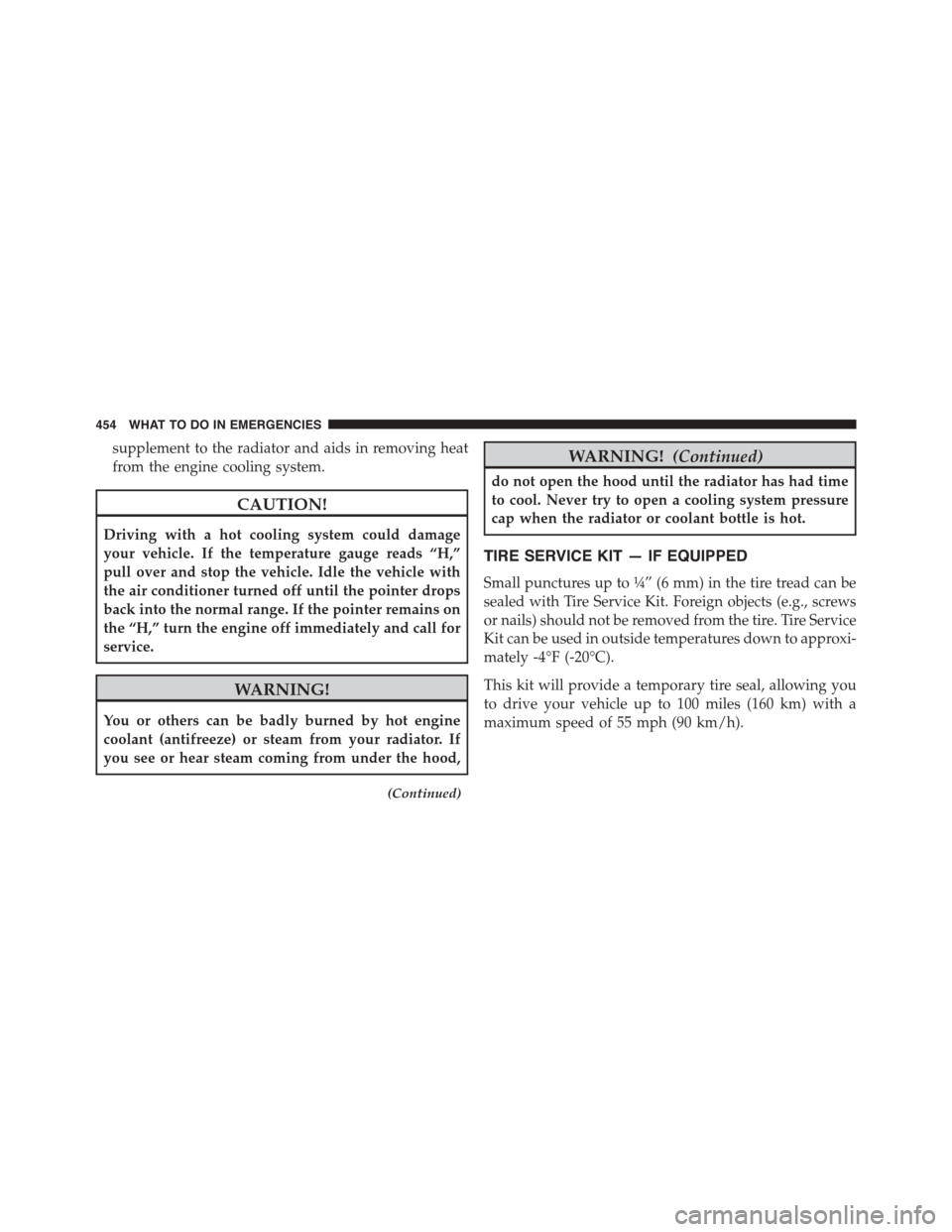
supplement to the radiator and aids in removing heat
from the engine cooling system.
CAUTION!
Driving with a hot cooling system could damage
your vehicle. If the temperature gauge reads “H,”
pull over and stop the vehicle. Idle the vehicle with
the air conditioner turned off until the pointer drops
back into the normal range. If the pointer remains on
the “H,” turn the engine off immediately and call for
service.
WARNING!
You or others can be badly burned by hot engine
coolant (antifreeze) or steam from your radiator. If
you see or hear steam coming from under the hood,
(Continued)
WARNING!(Continued)
do not open the hood until the radiator has had time
to cool. Never try to open a cooling system pressure
cap when the radiator or coolant bottle is hot.
TIRE SERVICE KIT — IF EQUIPPED
Small punctures up to¼” (6 mm) in the tire tread can be
sealed with Tire Service Kit. Foreign objects (e.g., screws
or nails) should not be removed from the tire. Tire Service
Kit can be used in outside temperatures down to approxi-
mately -4°F (-20°C).
This kit will provide a temporary tire seal, allowing you
to drive your vehicle up to 100 miles (160 km) with a
maximum speed of 55 mph (90 km/h).
454 WHAT TO DO IN EMERGENCIES
Page 513 of 603
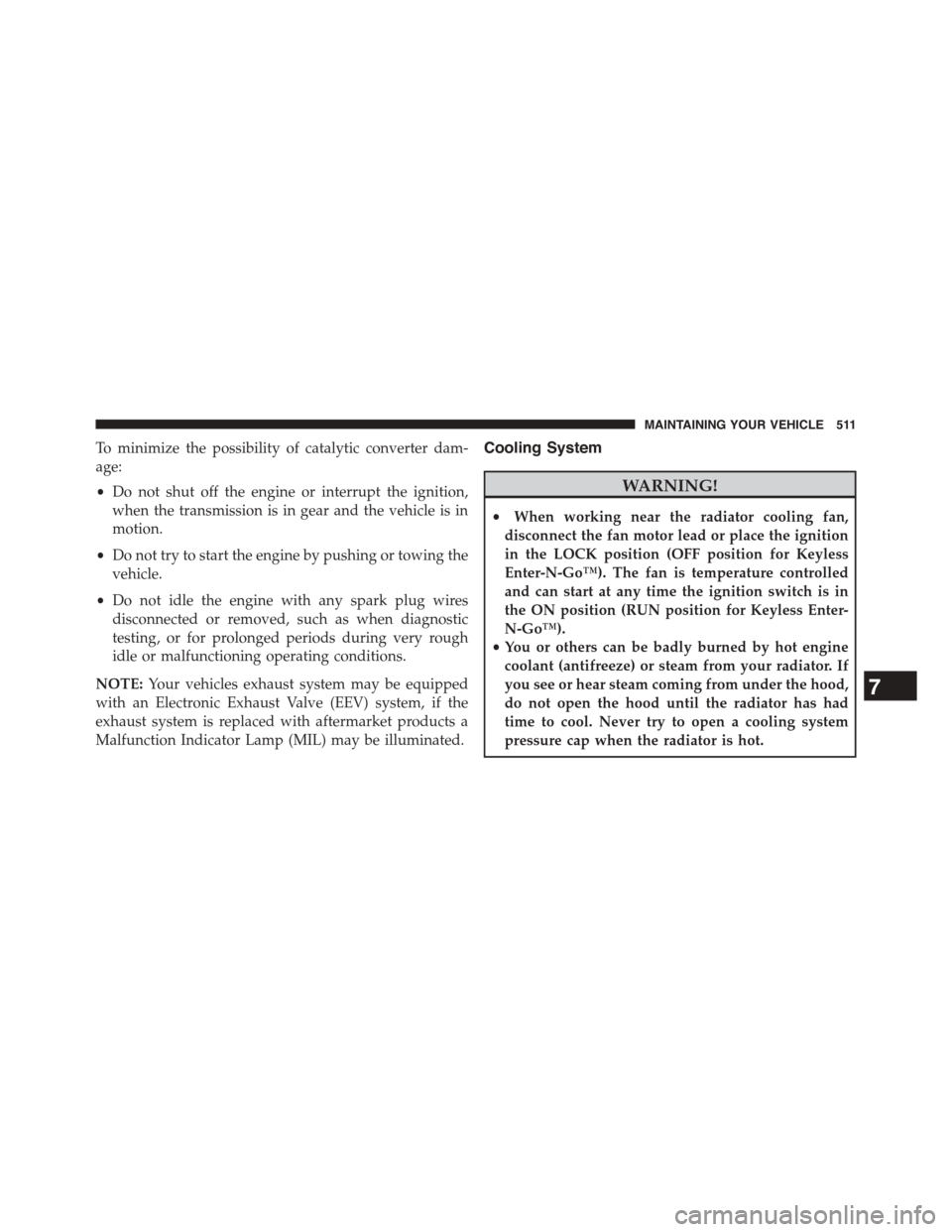
To minimize the possibility of catalytic converter dam-
age:
•Do not shut off the engine or interrupt the ignition,
when the transmission is in gear and the vehicle is in
motion.
•Do not try to start the engine by pushing or towing the
vehicle.
•Do not idle the engine with any spark plug wires
disconnected or removed, such as when diagnostic
testing, or for prolonged periods during very rough
idle or malfunctioning operating conditions.
NOTE:Your vehicles exhaust system may be equipped
with an Electronic Exhaust Valve (EEV) system, if the
exhaust system is replaced with aftermarket products a
Malfunction Indicator Lamp (MIL) may be illuminated.
Cooling System
WARNING!
•When working near the radiator cooling fan,
disconnect the fan motor lead or place the ignition
in the LOCK position (OFF position for Keyless
Enter-N-Go™). The fan is temperature controlled
and can start at any time the ignition switch is in
the ON position (RUN position for Keyless Enter-
N-Go™).
•You or others can be badly burned by hot engine
coolant (antifreeze) or steam from your radiator. If
you see or hear steam coming from under the hood,
do not open the hood until the radiator has had
time to cool. Never try to open a cooling system
pressure cap when the radiator is hot.
7
MAINTAINING YOUR VEHICLE 511
Page 514 of 603
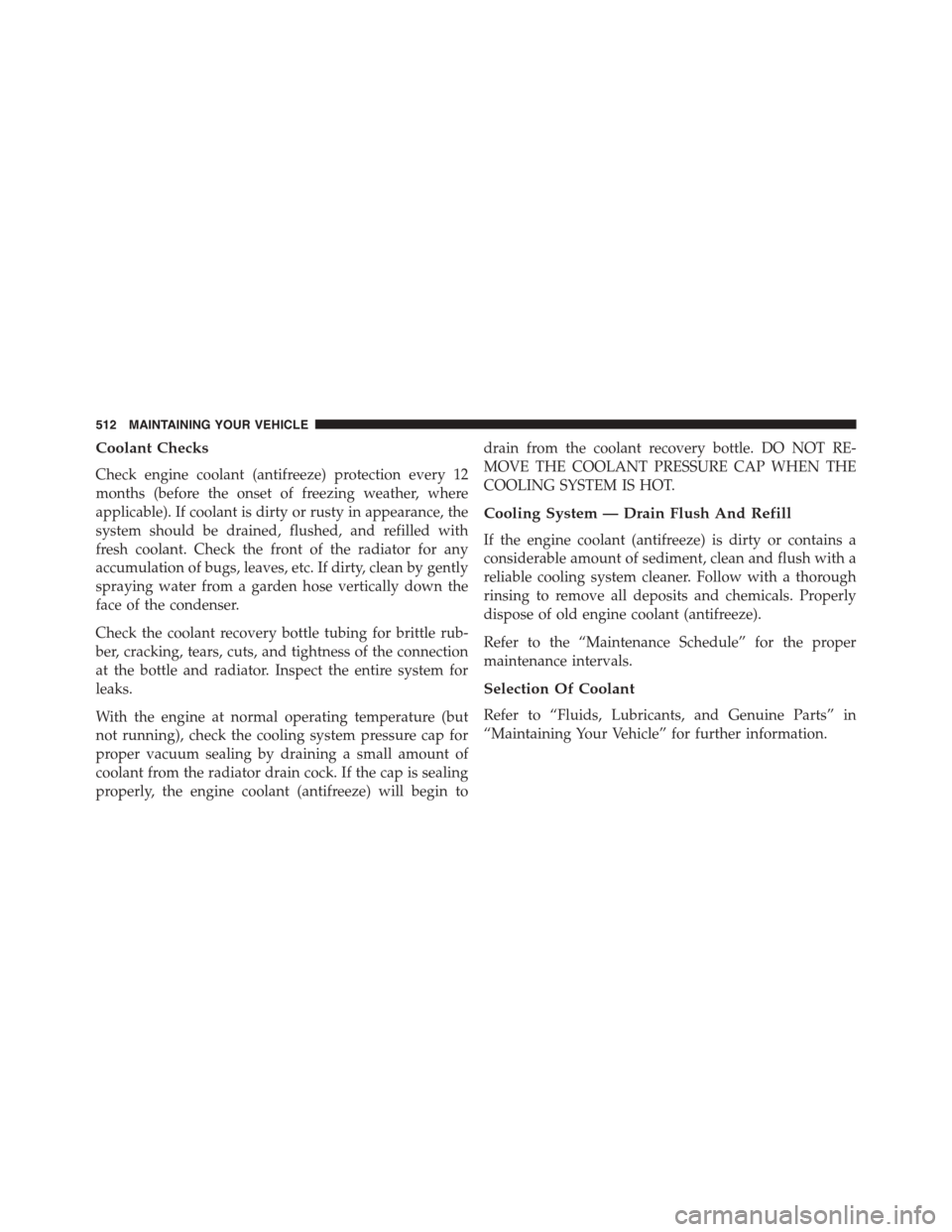
Coolant Checks
Check engine coolant (antifreeze) protection every 12
months (before the onset of freezing weather, where
applicable). If coolant is dirty or rusty in appearance, the
system should be drained, flushed, and refilled with
fresh coolant. Check the front of the radiator for any
accumulation of bugs, leaves, etc. If dirty, clean by gently
spraying water from a garden hose vertically down the
face of the condenser.
Check the coolant recovery bottle tubing for brittle rub-
ber, cracking, tears, cuts, and tightness of the connection
at the bottle and radiator. Inspect the entire system for
leaks.
With the engine at normal operating temperature (but
not running), check the cooling system pressure cap for
proper vacuum sealing by draining a small amount of
coolant from the radiator drain cock. If the cap is sealing
properly, the engine coolant (antifreeze) will begin to
drain from the coolant recovery bottle. DO NOT RE-
MOVE THE COOLANT PRESSURE CAP WHEN THE
COOLING SYSTEM IS HOT.
Cooling System — Drain Flush And Refill
If the engine coolant (antifreeze) is dirty or contains a
considerable amount of sediment, clean and flush with a
reliable cooling system cleaner. Follow with a thorough
rinsing to remove all deposits and chemicals. Properly
dispose of old engine coolant (antifreeze).
Refer to the “Maintenance Schedule” for the proper
maintenance intervals.
Selection Of Coolant
Refer to “Fluids, Lubricants, and Genuine Parts” in
“Maintaining Your Vehicle” for further information.
512 MAINTAINING YOUR VEHICLE
Page 517 of 603
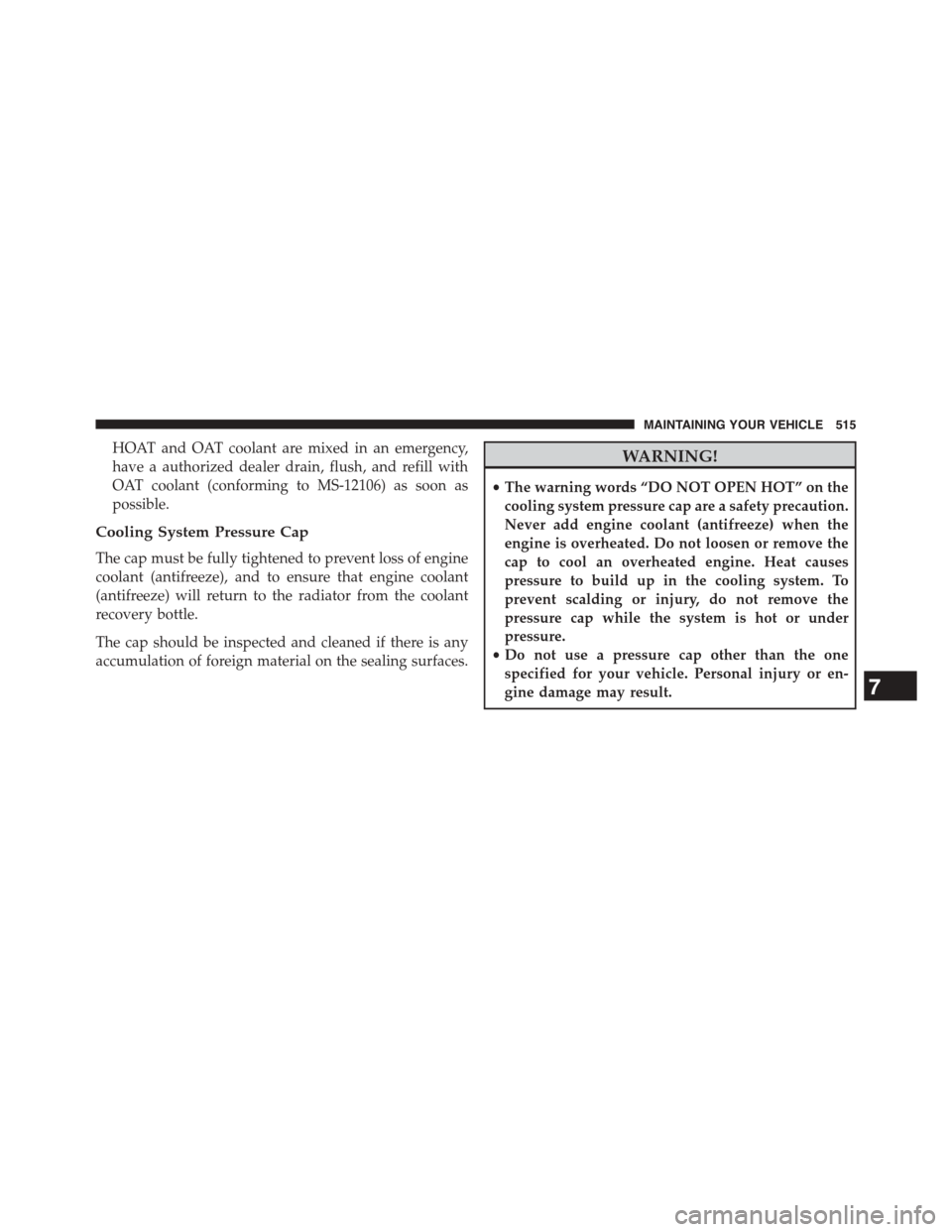
HOAT and OAT coolant are mixed in an emergency,
have a authorized dealer drain, flush, and refill with
OAT coolant (conforming to MS-12106) as soon as
possible.
Cooling System Pressure Cap
The cap must be fully tightened to prevent loss of engine
coolant (antifreeze), and to ensure that engine coolant
(antifreeze) will return to the radiator from the coolant
recovery bottle.
The cap should be inspected and cleaned if there is any
accumulation of foreign material on the sealing surfaces.
WARNING!
•The warning words “DO NOT OPEN HOT” on the
cooling system pressure cap are a safety precaution.
Never add engine coolant (antifreeze) when the
engine is overheated. Do not loosen or remove the
cap to cool an overheated engine. Heat causes
pressure to build up in the cooling system. To
prevent scalding or injury, do not remove the
pressure cap while the system is hot or under
pressure.
•Do not use a pressure cap other than the one
specified for your vehicle. Personal injury or en-
gine damage may result.7
MAINTAINING YOUR VEHICLE 515
Page 518 of 603
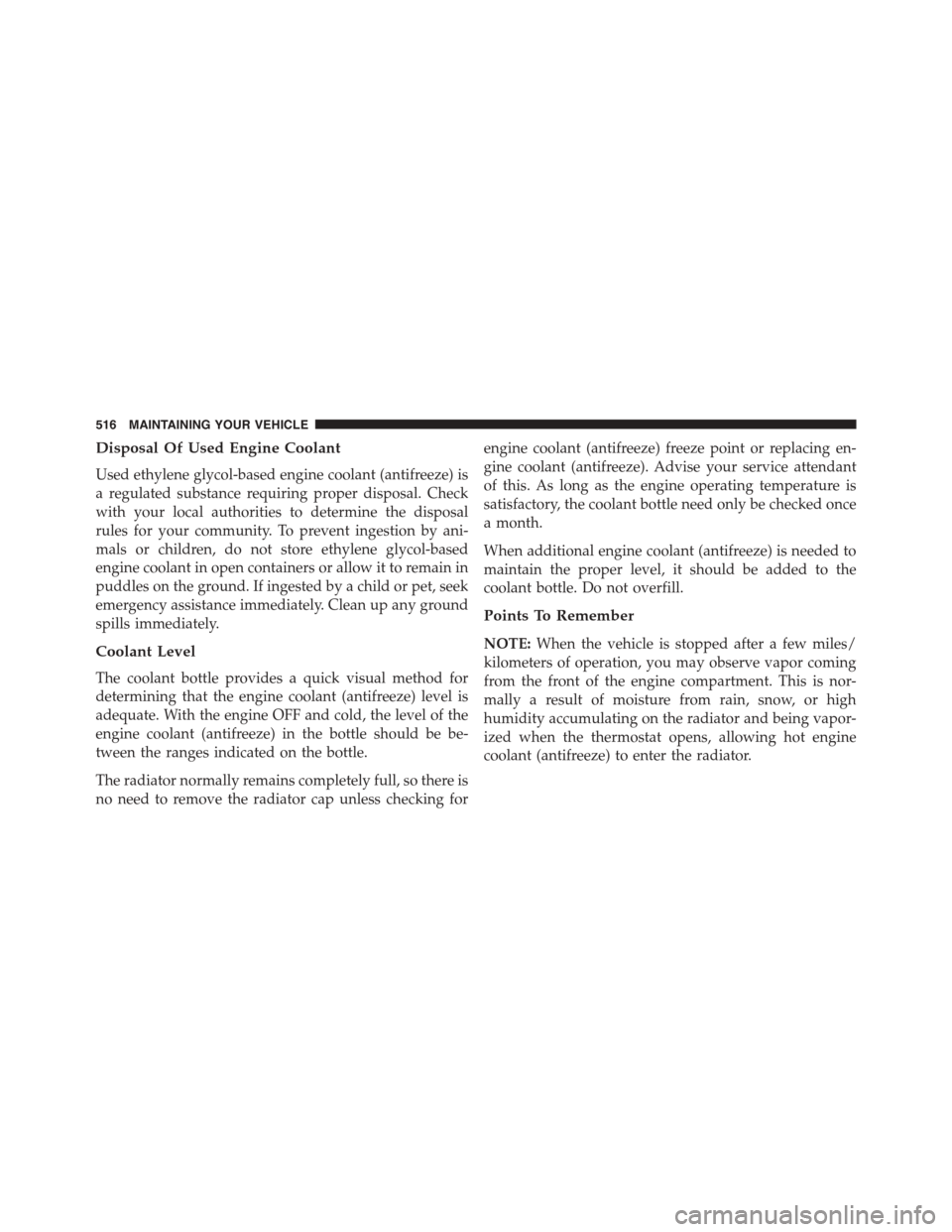
Disposal Of Used Engine Coolant
Used ethylene glycol-based engine coolant (antifreeze) is
a regulated substance requiring proper disposal. Check
with your local authorities to determine the disposal
rules for your community. To prevent ingestion by ani-
mals or children, do not store ethylene glycol-based
engine coolant in open containers or allow it to remain in
puddles on the ground. If ingested by a child or pet, seek
emergency assistance immediately. Clean up any ground
spills immediately.
Coolant Level
The coolant bottle provides a quick visual method for
determining that the engine coolant (antifreeze) level is
adequate. With the engine OFF and cold, the level of the
engine coolant (antifreeze) in the bottle should be be-
tween the ranges indicated on the bottle.
The radiator normally remains completely full, so there is
no need to remove the radiator cap unless checking for
engine coolant (antifreeze) freeze point or replacing en-
gine coolant (antifreeze). Advise your service attendant
of this. As long as the engine operating temperature is
satisfactory, the coolant bottle need only be checked once
a month.
When additional engine coolant (antifreeze) is needed to
maintain the proper level, it should be added to the
coolant bottle. Do not overfill.
Points To Remember
NOTE:When the vehicle is stopped after a few miles/
kilometers of operation, you may observe vapor coming
from the front of the engine compartment. This is nor-
mally a result of moisture from rain, snow, or high
humidity accumulating on the radiator and being vapor-
ized when the thermostat opens, allowing hot engine
coolant (antifreeze) to enter the radiator.
516 MAINTAINING YOUR VEHICLE
Page 584 of 603

Anti-Lock (ABS)........................382
Fluid Check...........................518
Master Cylinder........................518
Parking..............................377
Warning Light.........................227
Brake/Transmission Interlock.................361
Break-In Recommendations, New Vehicle.........90
Brightness, Interior Lights...................145
Bulb Replacement.........................543
Bulbs, Light..............................97
Camera, Rear............................195
Capacities, Fluid..........................548
Caps, Filler
Fuel.................................431
Oil (Engine)...........................499
Radiator (Coolant Pressure)................515
Carbon Monoxide Warning...................94
Cargo (Vehicle Loading)....................433
Car Washes.............................524
Cellular Phone...........................312
Center High Mounted Stop Light..............547
Certification Label.........................433
Chains, Tire.............................415
Changing A Flat Tire.......................466
Chart, Tire Sizing.........................393
Check Engine Light (Malfunction Indicator Light) . .493
Checking Your Vehicle For Safety...............93
Checks, Safety............................93
Child Restraint............................69
Child Restraints
Booster Seats...........................74
Center Seat LATCH......................82
Child Restraints.........................69
Child Seat Installation.....................87
How To Stow An Unused ALR Seat Belt........83
Infants And Child Restraints................72
Install A LATCH-compatible Child Restraint.....82
582 INDEX
Page 585 of 603
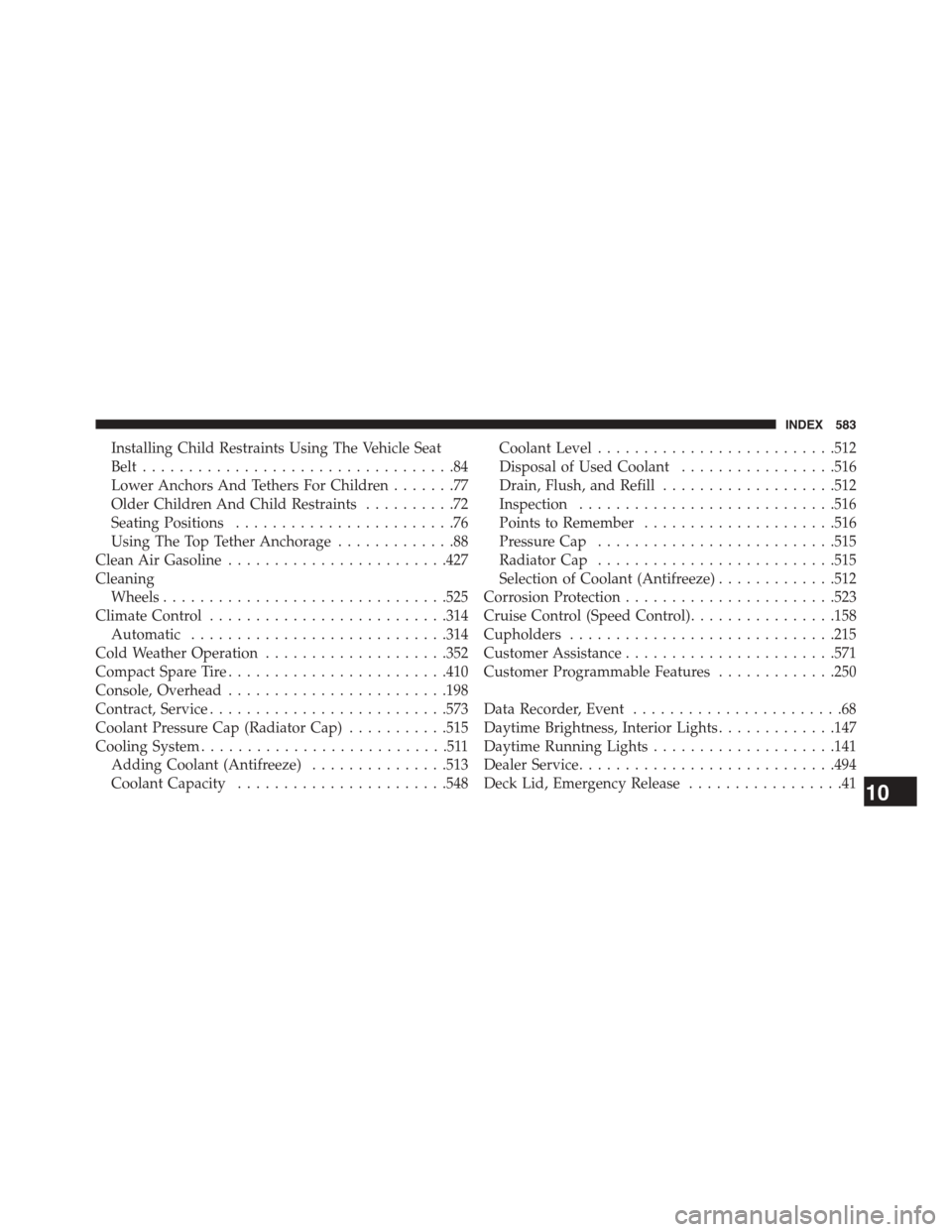
Installing Child Restraints Using The Vehicle Seat
Belt..................................84
Lower Anchors And Tethers For Children.......77
Older Children And Child Restraints..........72
Seating Positions........................76
Using The Top Tether Anchorage.............88
Clean Air Gasoline........................427
Cleaning
Wheels...............................525
Climate Control..........................314
Automatic............................314
Cold Weather Operation....................352
Compact Spare Tire........................410
Console, Overhead........................198
Contract, Service..........................573
Coolant Pressure Cap (Radiator Cap)...........515
Cooling System...........................511
Adding Coolant (Antifreeze)...............513
Coolant Capacity.......................548
Coolant Level..........................512
Disposal of Used Coolant.................516
Drain, Flush, and Refill...................512
Inspection............................516
Points to Remember.....................516
Pressure Cap..........................515
Radiator Cap..........................515
Selection of Coolant (Antifreeze).............512
Corrosion Protection.......................523
Cruise Control (Speed Control)................158
Cupholders.............................215
Customer Assistance.......................571
Customer Programmable Features.............250
Data Recorder, Event.......................68
Daytime Brightness, Interior Lights.............147
Daytime Running Lights....................141
Dealer Service............................494
Deck Lid, Emergency Release.................4110
INDEX 583
Page 595 of 603
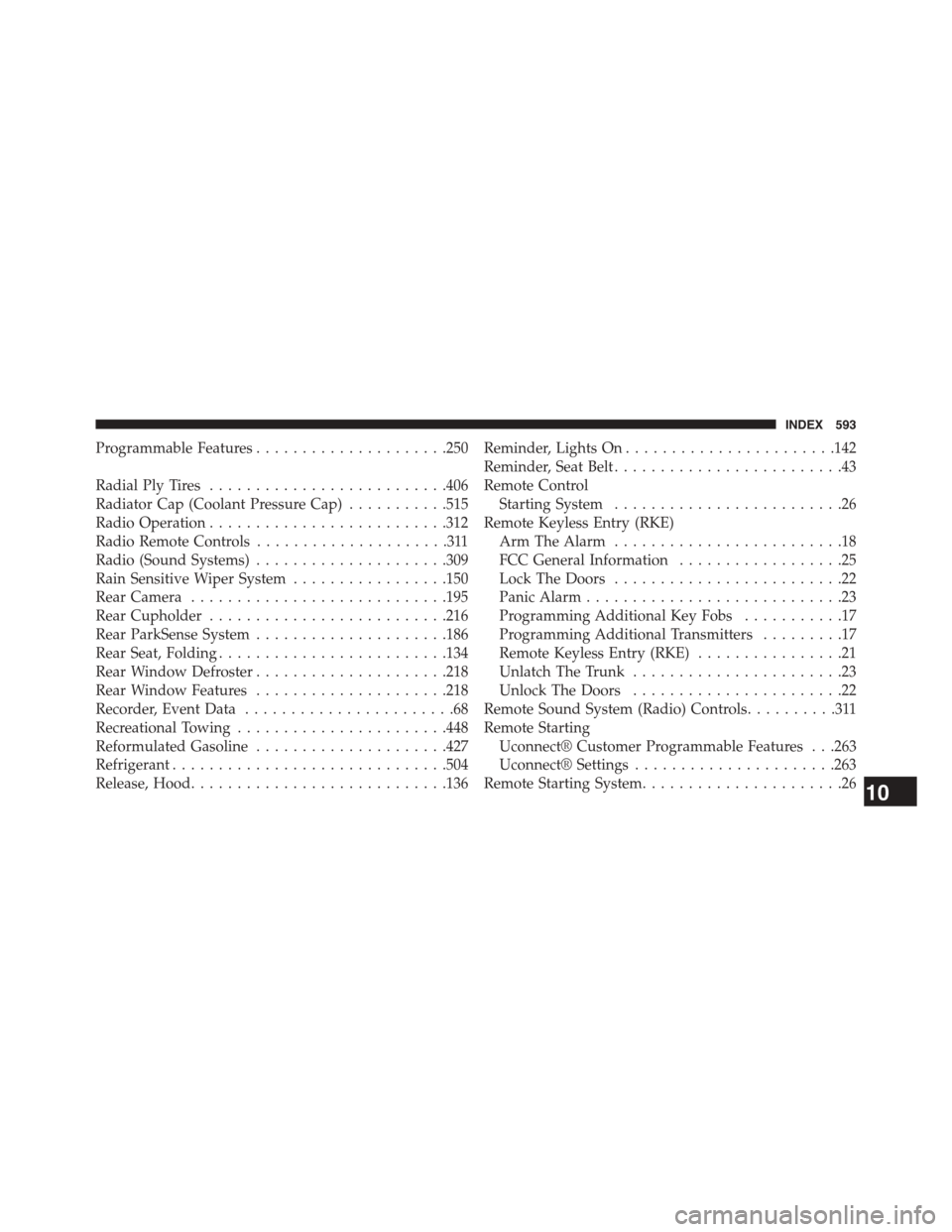
Programmable Features.....................250
Radial Ply Tires..........................406
Radiator Cap (Coolant Pressure Cap)...........515
Radio Operation..........................312
Radio Remote Controls.....................311
Radio (Sound Systems).....................309
Rain Sensitive Wiper System.................150
Rear Camera............................195
Rear Cupholder..........................216
Rear ParkSense System.....................186
Rear Seat, Folding.........................134
Rear Window Defroster.....................218
Rear Window Features.....................218
Recorder, Event Data.......................68
Recreational Towing.......................448
Reformulated Gasoline.....................427
Refrigerant..............................504
Release, Hood............................136
Reminder, Lights On.......................142
Reminder, Seat Belt.........................43
Remote Control
Starting System.........................26
Remote Keyless Entry (RKE)
Arm The Alarm.........................18
FCC General Information..................25
Lock The Doors.........................22
Panic Alarm............................23
Programming Additional Key Fobs...........17
Programming Additional Transmitters.........17
Remote Keyless Entry (RKE)................21
Unlatch The Trunk.......................23
Unlock The Doors.......................22
Remote Sound System (Radio) Controls..........311
Remote Starting
Uconnect® Customer Programmable Features . . .263
Uconnect® Settings......................263
Remote Starting System......................2610
INDEX 593